Evaluating Child and Young People Development in Residential Childcare
VerifiedAdded on 2023/01/13
|8
|2294
|79
Report
AI Summary
This report delves into the multifaceted aspects of child and young people's development within residential childcare settings. It begins by emphasizing the significance of observation in assessment and monitoring, highlighting its role in establishing effective treatment plans and identifying developmental changes. The report then examines the impact of interventions on children who do not follow expected developmental patterns, underscoring the role of educational psychologists and special educational needs coordinators. Furthermore, it explores how multidisciplinary teams address children's developmental needs, emphasizing the importance of integrated care and collaborative decision-making. The report also discusses the influence of daily activities, such as creative and physical activities, on cognitive and physical development. It analyzes the relevance of early identification of developmental issues, including speech and language disorders, and the impact of transitions on children's development. Finally, the report evaluates the positive effects of relationships during transition periods, concluding with a summary of key findings and references.

Understand the Development
of Children and Young People
in Residential Childcare
of Children and Young People
in Residential Childcare
Paraphrase This Document
Need a fresh take? Get an instant paraphrase of this document with our AI Paraphraser
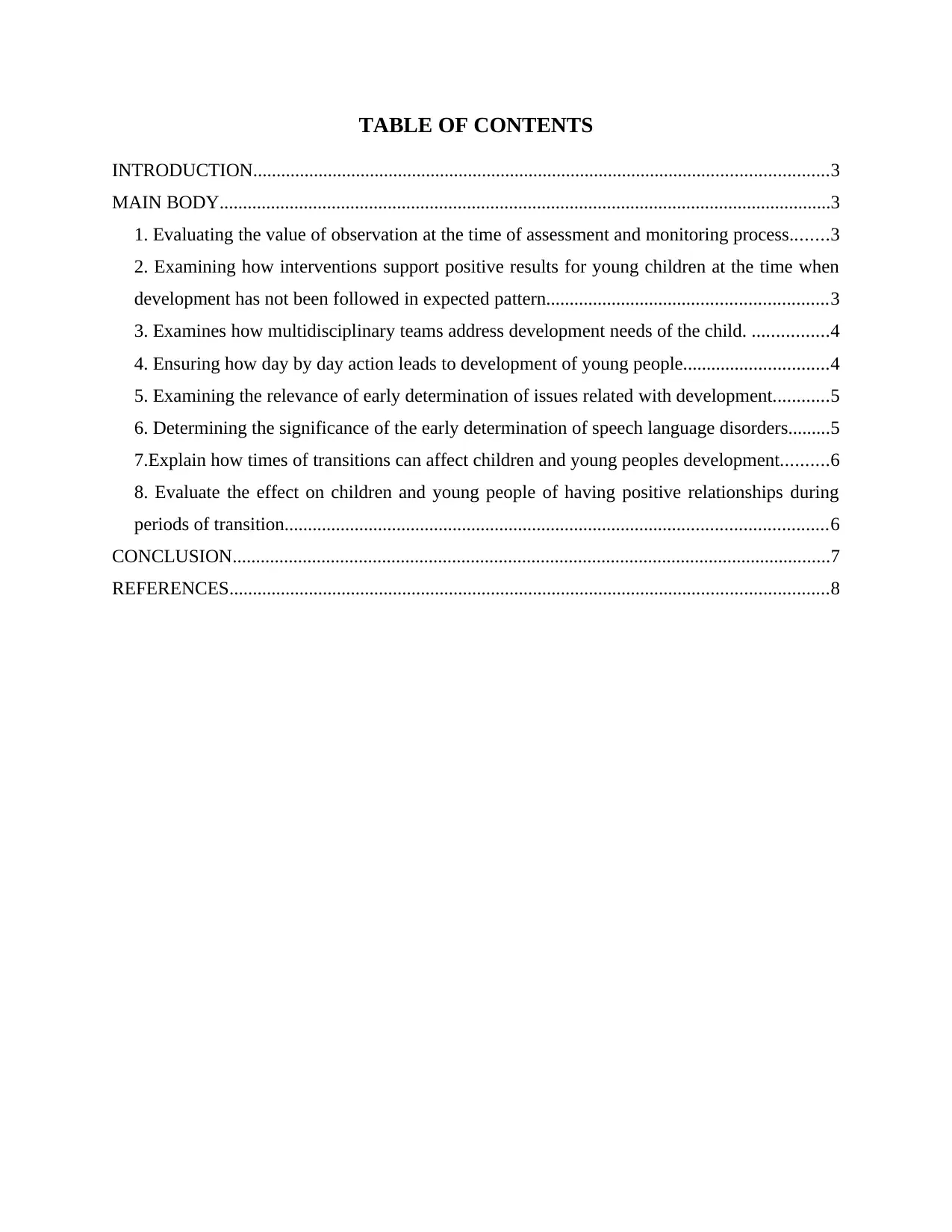
TABLE OF CONTENTS
INTRODUCTION...........................................................................................................................3
MAIN BODY...................................................................................................................................3
1. Evaluating the value of observation at the time of assessment and monitoring process........3
2. Examining how interventions support positive results for young children at the time when
development has not been followed in expected pattern............................................................3
3. Examines how multidisciplinary teams address development needs of the child. ................4
4. Ensuring how day by day action leads to development of young people...............................4
5. Examining the relevance of early determination of issues related with development............5
6. Determining the significance of the early determination of speech language disorders.........5
7.Explain how times of transitions can affect children and young peoples development..........6
8. Evaluate the effect on children and young people of having positive relationships during
periods of transition....................................................................................................................6
CONCLUSION................................................................................................................................7
REFERENCES................................................................................................................................8
INTRODUCTION...........................................................................................................................3
MAIN BODY...................................................................................................................................3
1. Evaluating the value of observation at the time of assessment and monitoring process........3
2. Examining how interventions support positive results for young children at the time when
development has not been followed in expected pattern............................................................3
3. Examines how multidisciplinary teams address development needs of the child. ................4
4. Ensuring how day by day action leads to development of young people...............................4
5. Examining the relevance of early determination of issues related with development............5
6. Determining the significance of the early determination of speech language disorders.........5
7.Explain how times of transitions can affect children and young peoples development..........6
8. Evaluate the effect on children and young people of having positive relationships during
periods of transition....................................................................................................................6
CONCLUSION................................................................................................................................7
REFERENCES................................................................................................................................8
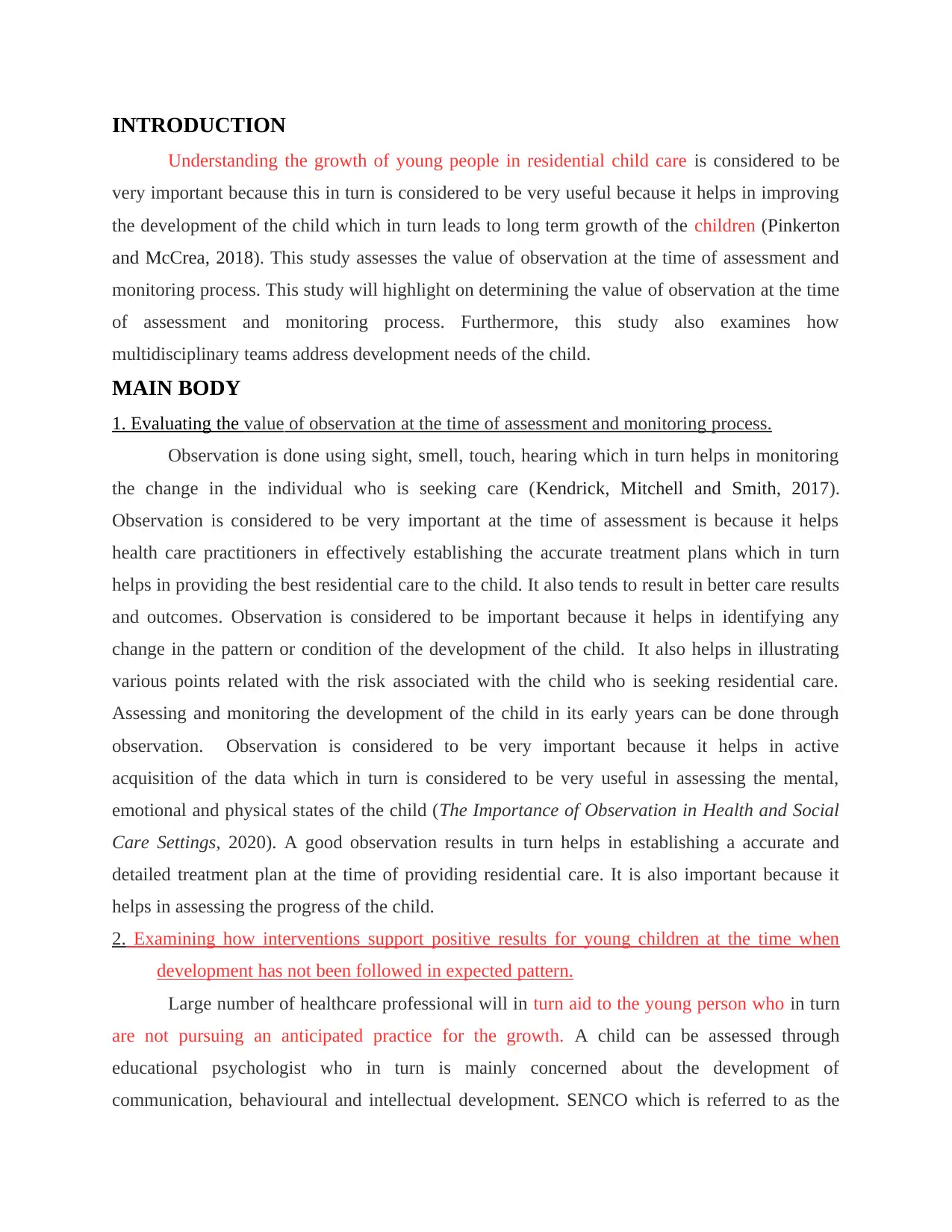
INTRODUCTION
Understanding the growth of young people in residential child care is considered to be
very important because this in turn is considered to be very useful because it helps in improving
the development of the child which in turn leads to long term growth of the children (Pinkerton
and McCrea, 2018). This study assesses the value of observation at the time of assessment and
monitoring process. This study will highlight on determining the value of observation at the time
of assessment and monitoring process. Furthermore, this study also examines how
multidisciplinary teams address development needs of the child.
MAIN BODY
1. Evaluating the value of observation at the time of assessment and monitoring process.
Observation is done using sight, smell, touch, hearing which in turn helps in monitoring
the change in the individual who is seeking care (Kendrick, Mitchell and Smith, 2017).
Observation is considered to be very important at the time of assessment is because it helps
health care practitioners in effectively establishing the accurate treatment plans which in turn
helps in providing the best residential care to the child. It also tends to result in better care results
and outcomes. Observation is considered to be important because it helps in identifying any
change in the pattern or condition of the development of the child. It also helps in illustrating
various points related with the risk associated with the child who is seeking residential care.
Assessing and monitoring the development of the child in its early years can be done through
observation. Observation is considered to be very important because it helps in active
acquisition of the data which in turn is considered to be very useful in assessing the mental,
emotional and physical states of the child (The Importance of Observation in Health and Social
Care Settings, 2020). A good observation results in turn helps in establishing a accurate and
detailed treatment plan at the time of providing residential care. It is also important because it
helps in assessing the progress of the child.
2. Examining how interventions support positive results for young children at the time when
development has not been followed in expected pattern.
Large number of healthcare professional will in turn aid to the young person who in turn
are not pursuing an anticipated practice for the growth. A child can be assessed through
educational psychologist who in turn is mainly concerned about the development of
communication, behavioural and intellectual development. SENCO which is referred to as the
Understanding the growth of young people in residential child care is considered to be
very important because this in turn is considered to be very useful because it helps in improving
the development of the child which in turn leads to long term growth of the children (Pinkerton
and McCrea, 2018). This study assesses the value of observation at the time of assessment and
monitoring process. This study will highlight on determining the value of observation at the time
of assessment and monitoring process. Furthermore, this study also examines how
multidisciplinary teams address development needs of the child.
MAIN BODY
1. Evaluating the value of observation at the time of assessment and monitoring process.
Observation is done using sight, smell, touch, hearing which in turn helps in monitoring
the change in the individual who is seeking care (Kendrick, Mitchell and Smith, 2017).
Observation is considered to be very important at the time of assessment is because it helps
health care practitioners in effectively establishing the accurate treatment plans which in turn
helps in providing the best residential care to the child. It also tends to result in better care results
and outcomes. Observation is considered to be important because it helps in identifying any
change in the pattern or condition of the development of the child. It also helps in illustrating
various points related with the risk associated with the child who is seeking residential care.
Assessing and monitoring the development of the child in its early years can be done through
observation. Observation is considered to be very important because it helps in active
acquisition of the data which in turn is considered to be very useful in assessing the mental,
emotional and physical states of the child (The Importance of Observation in Health and Social
Care Settings, 2020). A good observation results in turn helps in establishing a accurate and
detailed treatment plan at the time of providing residential care. It is also important because it
helps in assessing the progress of the child.
2. Examining how interventions support positive results for young children at the time when
development has not been followed in expected pattern.
Large number of healthcare professional will in turn aid to the young person who in turn
are not pursuing an anticipated practice for the growth. A child can be assessed through
educational psychologist who in turn is mainly concerned about the development of
communication, behavioural and intellectual development. SENCO which is referred to as the
⊘ This is a preview!⊘
Do you want full access?
Subscribe today to unlock all pages.

Trusted by 1+ million students worldwide

special educational needs coordinator helps in providing right treatment to the child seeking care.
Intervention tends to create and promote a positive environment for child who has not followed
an expected pattern for development. This helps in making the most of the skills and abilities
which in turn has been developed during young age of the individual.
3. Examines how multidisciplinary teams address development needs of the child.
A multi- agency or multidisciplinary team in the health and social care mainly consist of
range of disciplinary workers, care workers, nurses, doctors and several other health care
practitioners (Happ, Glossop and Ogi, 2018). A multi- agency team tends to work across various
organization which in turn helps in delivering various services to the child for growth and
development. A multi- agency team tends to focus on providing customized learning and
experience which helps in the development of the child. They must focus on providing integrated
care in order to improve the social, behavioural and learning skills which in turn is considered to
be very useful in the development of the needs of the child (Profile, 2016). A multi- agency
team can work collaboratively to contribute towards early intervention services among child.
This team also tend to render timely assistance to the young individual who in turn are seeking
residential child care. They also address development needs of the child by collaboratively
taking decision which in turn is useful in gaining better care results and outcomes.
4. Ensuring how day by day action leads to development of young people.
Creative act in turn helps children in developing cognitive and intellectual development
skills. This activity is considered to be very useful in developing concentration power, critical
thinking skills and imagination skills (Holmes and et.al., 2018). Physical activity like bouncing,
hitting, kicking, running, walking, catching, jumping, etc. among young children in turn helps in
effectively improving the strength and also results in healthy body composition, muscles and
stronger bones. It is considered to be useful in maintaining healthy body weight which in turn
results in higher goals and objectives. High degree of physical activity among the young people
helps child to remain active by controlling the body weight. Playing activities helps in
developing the concentration level of the child and also develop various essential skills such as
team working, problem solving skills, etc. Physical interaction with the child helps in developing
the brain functioning of the child.
Intervention tends to create and promote a positive environment for child who has not followed
an expected pattern for development. This helps in making the most of the skills and abilities
which in turn has been developed during young age of the individual.
3. Examines how multidisciplinary teams address development needs of the child.
A multi- agency or multidisciplinary team in the health and social care mainly consist of
range of disciplinary workers, care workers, nurses, doctors and several other health care
practitioners (Happ, Glossop and Ogi, 2018). A multi- agency team tends to work across various
organization which in turn helps in delivering various services to the child for growth and
development. A multi- agency team tends to focus on providing customized learning and
experience which helps in the development of the child. They must focus on providing integrated
care in order to improve the social, behavioural and learning skills which in turn is considered to
be very useful in the development of the needs of the child (Profile, 2016). A multi- agency
team can work collaboratively to contribute towards early intervention services among child.
This team also tend to render timely assistance to the young individual who in turn are seeking
residential child care. They also address development needs of the child by collaboratively
taking decision which in turn is useful in gaining better care results and outcomes.
4. Ensuring how day by day action leads to development of young people.
Creative act in turn helps children in developing cognitive and intellectual development
skills. This activity is considered to be very useful in developing concentration power, critical
thinking skills and imagination skills (Holmes and et.al., 2018). Physical activity like bouncing,
hitting, kicking, running, walking, catching, jumping, etc. among young children in turn helps in
effectively improving the strength and also results in healthy body composition, muscles and
stronger bones. It is considered to be useful in maintaining healthy body weight which in turn
results in higher goals and objectives. High degree of physical activity among the young people
helps child to remain active by controlling the body weight. Playing activities helps in
developing the concentration level of the child and also develop various essential skills such as
team working, problem solving skills, etc. Physical interaction with the child helps in developing
the brain functioning of the child.
Paraphrase This Document
Need a fresh take? Get an instant paraphrase of this document with our AI Paraphraser

5. Examining the relevance of early determination of issues related with development.
Development issues associated with learning disability, disruptive mood dysregulation
disorder. Problems associated with the vision problems, cognitive delays, problem in
understanding, etc. are in turn considered to be the key issues which in turn largely affects the
development needs of the child. Early identification of development issues and recognizing
difficulties quickly in turn helps in prompting early intervention to the child. Providing early
intervention to the child in turn helps in assisting child to make the most of its developed skills
and abilities at a young age (Frost and Mills, 2019). Other key development issues related with
the motor skills development, emotional development, understanding language, cultural and
social influence, cognitive development, etc. in turn are considered to be key issues which in turn
eventually influence the development of the child or young people. Abnormal patterns and issues
which in turn are mainly linked with the area of communication, adaptive behaviour, cognitive
skills, etc. This in turn largely hampers the growth and development of the child. The health care
practitioners in turn mainly focuses on cognitive behaviour therapy. This in turn helps in
addressing various developmental issues and provide proper intervention to the child on a timely
manner (Kendrick, Mitchell and Smith, 2017). Early identification of issues related with
development helps young child in performing better in the mere future.
6. Determining the significance of the early determination of speech language disorders.
The possible risk associated with the language disorders among the child tends to have
relevant effect on the social, academic, vocational and private life of the children. Early
determination of the speech communication disorders in turn helps in increasing the chance of
improving the vocational and communications skills among child (Happ, Glossop and Ogi,
2018). The potential risk which in turn is associated with the late recognition of the speech
language is mainly associated with the disorders related with developmental such as delayed
communication, neurological defects, etc. Early determination of speech communication
disorders in turn helps in providing right treatment to the child and also helps in reducing the risk
associated with the late identification of speech language disorders. Early identification in turn
helps in exploding the possibility of improving the speech language and communication skills
among young people.
Development issues associated with learning disability, disruptive mood dysregulation
disorder. Problems associated with the vision problems, cognitive delays, problem in
understanding, etc. are in turn considered to be the key issues which in turn largely affects the
development needs of the child. Early identification of development issues and recognizing
difficulties quickly in turn helps in prompting early intervention to the child. Providing early
intervention to the child in turn helps in assisting child to make the most of its developed skills
and abilities at a young age (Frost and Mills, 2019). Other key development issues related with
the motor skills development, emotional development, understanding language, cultural and
social influence, cognitive development, etc. in turn are considered to be key issues which in turn
eventually influence the development of the child or young people. Abnormal patterns and issues
which in turn are mainly linked with the area of communication, adaptive behaviour, cognitive
skills, etc. This in turn largely hampers the growth and development of the child. The health care
practitioners in turn mainly focuses on cognitive behaviour therapy. This in turn helps in
addressing various developmental issues and provide proper intervention to the child on a timely
manner (Kendrick, Mitchell and Smith, 2017). Early identification of issues related with
development helps young child in performing better in the mere future.
6. Determining the significance of the early determination of speech language disorders.
The possible risk associated with the language disorders among the child tends to have
relevant effect on the social, academic, vocational and private life of the children. Early
determination of the speech communication disorders in turn helps in increasing the chance of
improving the vocational and communications skills among child (Happ, Glossop and Ogi,
2018). The potential risk which in turn is associated with the late recognition of the speech
language is mainly associated with the disorders related with developmental such as delayed
communication, neurological defects, etc. Early determination of speech communication
disorders in turn helps in providing right treatment to the child and also helps in reducing the risk
associated with the late identification of speech language disorders. Early identification in turn
helps in exploding the possibility of improving the speech language and communication skills
among young people.
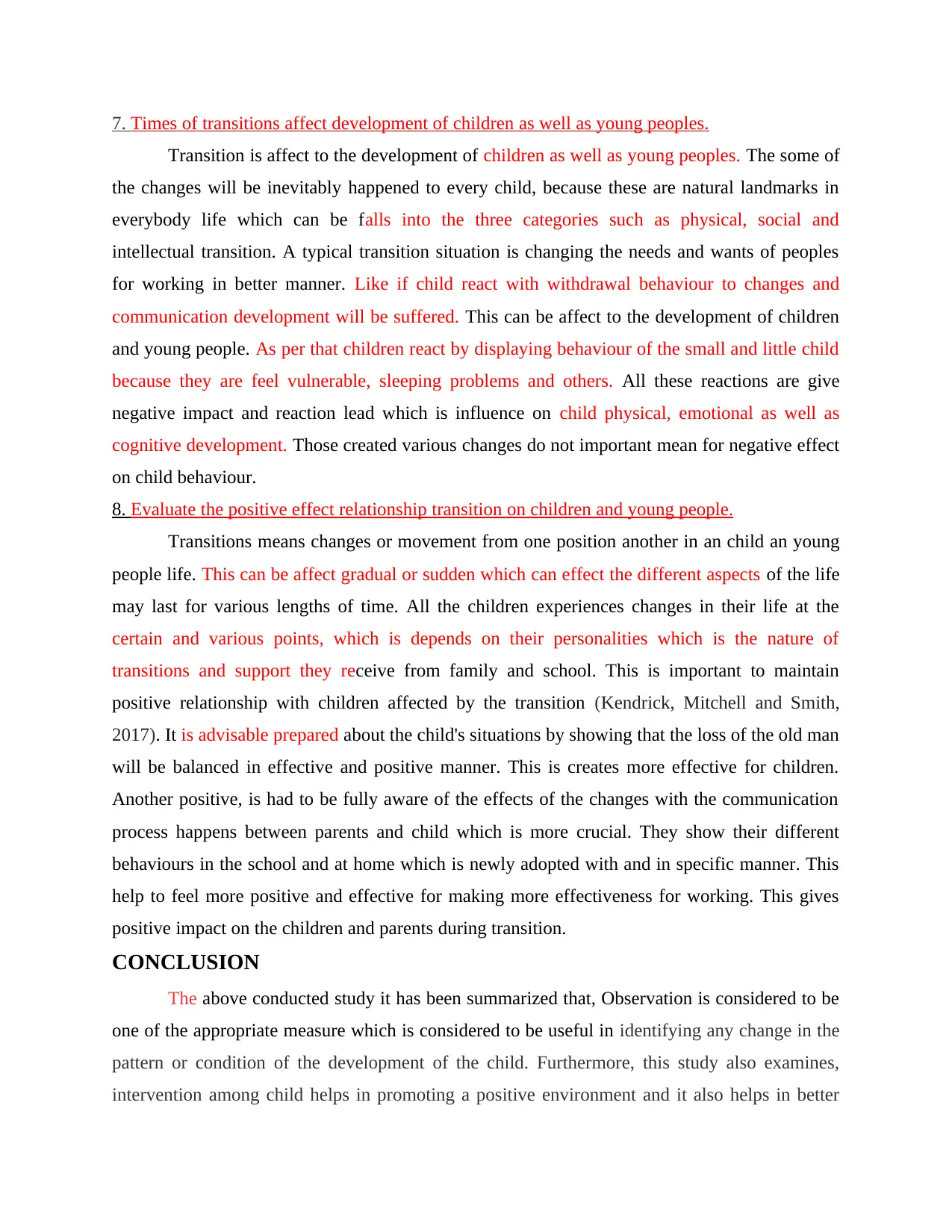
7. Times of transitions affect development of children as well as young peoples.
Transition is affect to the development of children as well as young peoples. The some of
the changes will be inevitably happened to every child, because these are natural landmarks in
everybody life which can be falls into the three categories such as physical, social and
intellectual transition. A typical transition situation is changing the needs and wants of peoples
for working in better manner. Like if child react with withdrawal behaviour to changes and
communication development will be suffered. This can be affect to the development of children
and young people. As per that children react by displaying behaviour of the small and little child
because they are feel vulnerable, sleeping problems and others. All these reactions are give
negative impact and reaction lead which is influence on child physical, emotional as well as
cognitive development. Those created various changes do not important mean for negative effect
on child behaviour.
8. Evaluate the positive effect relationship transition on children and young people.
Transitions means changes or movement from one position another in an child an young
people life. This can be affect gradual or sudden which can effect the different aspects of the life
may last for various lengths of time. All the children experiences changes in their life at the
certain and various points, which is depends on their personalities which is the nature of
transitions and support they receive from family and school. This is important to maintain
positive relationship with children affected by the transition (Kendrick, Mitchell and Smith,
2017). It is advisable prepared about the child's situations by showing that the loss of the old man
will be balanced in effective and positive manner. This is creates more effective for children.
Another positive, is had to be fully aware of the effects of the changes with the communication
process happens between parents and child which is more crucial. They show their different
behaviours in the school and at home which is newly adopted with and in specific manner. This
help to feel more positive and effective for making more effectiveness for working. This gives
positive impact on the children and parents during transition.
CONCLUSION
The above conducted study it has been summarized that, Observation is considered to be
one of the appropriate measure which is considered to be useful in identifying any change in the
pattern or condition of the development of the child. Furthermore, this study also examines,
intervention among child helps in promoting a positive environment and it also helps in better
Transition is affect to the development of children as well as young peoples. The some of
the changes will be inevitably happened to every child, because these are natural landmarks in
everybody life which can be falls into the three categories such as physical, social and
intellectual transition. A typical transition situation is changing the needs and wants of peoples
for working in better manner. Like if child react with withdrawal behaviour to changes and
communication development will be suffered. This can be affect to the development of children
and young people. As per that children react by displaying behaviour of the small and little child
because they are feel vulnerable, sleeping problems and others. All these reactions are give
negative impact and reaction lead which is influence on child physical, emotional as well as
cognitive development. Those created various changes do not important mean for negative effect
on child behaviour.
8. Evaluate the positive effect relationship transition on children and young people.
Transitions means changes or movement from one position another in an child an young
people life. This can be affect gradual or sudden which can effect the different aspects of the life
may last for various lengths of time. All the children experiences changes in their life at the
certain and various points, which is depends on their personalities which is the nature of
transitions and support they receive from family and school. This is important to maintain
positive relationship with children affected by the transition (Kendrick, Mitchell and Smith,
2017). It is advisable prepared about the child's situations by showing that the loss of the old man
will be balanced in effective and positive manner. This is creates more effective for children.
Another positive, is had to be fully aware of the effects of the changes with the communication
process happens between parents and child which is more crucial. They show their different
behaviours in the school and at home which is newly adopted with and in specific manner. This
help to feel more positive and effective for making more effectiveness for working. This gives
positive impact on the children and parents during transition.
CONCLUSION
The above conducted study it has been summarized that, Observation is considered to be
one of the appropriate measure which is considered to be useful in identifying any change in the
pattern or condition of the development of the child. Furthermore, this study also examines,
intervention among child helps in promoting a positive environment and it also helps in better
⊘ This is a preview!⊘
Do you want full access?
Subscribe today to unlock all pages.

Trusted by 1+ million students worldwide
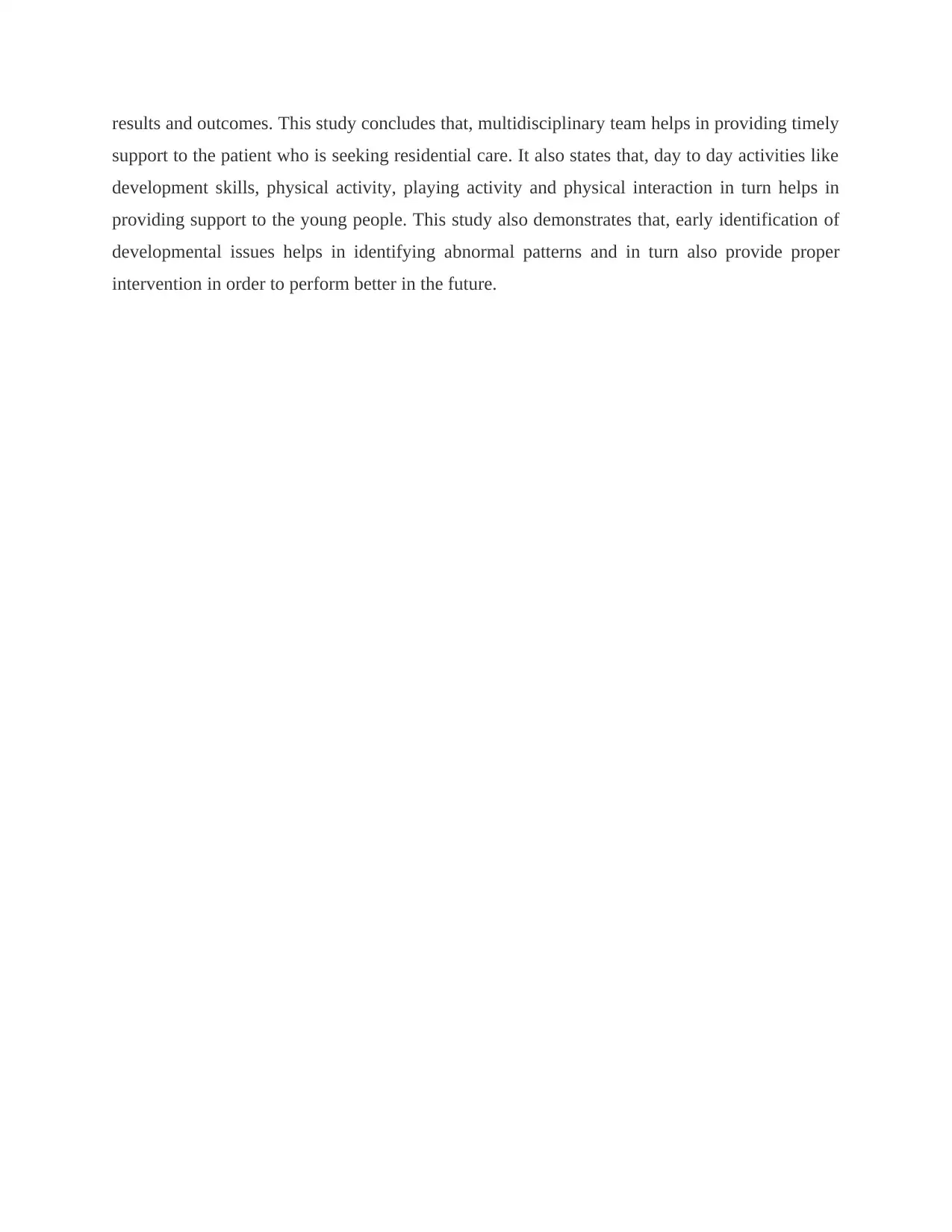
results and outcomes. This study concludes that, multidisciplinary team helps in providing timely
support to the patient who is seeking residential care. It also states that, day to day activities like
development skills, physical activity, playing activity and physical interaction in turn helps in
providing support to the young people. This study also demonstrates that, early identification of
developmental issues helps in identifying abnormal patterns and in turn also provide proper
intervention in order to perform better in the future.
support to the patient who is seeking residential care. It also states that, day to day activities like
development skills, physical activity, playing activity and physical interaction in turn helps in
providing support to the young people. This study also demonstrates that, early identification of
developmental issues helps in identifying abnormal patterns and in turn also provide proper
intervention in order to perform better in the future.
Paraphrase This Document
Need a fresh take? Get an instant paraphrase of this document with our AI Paraphraser
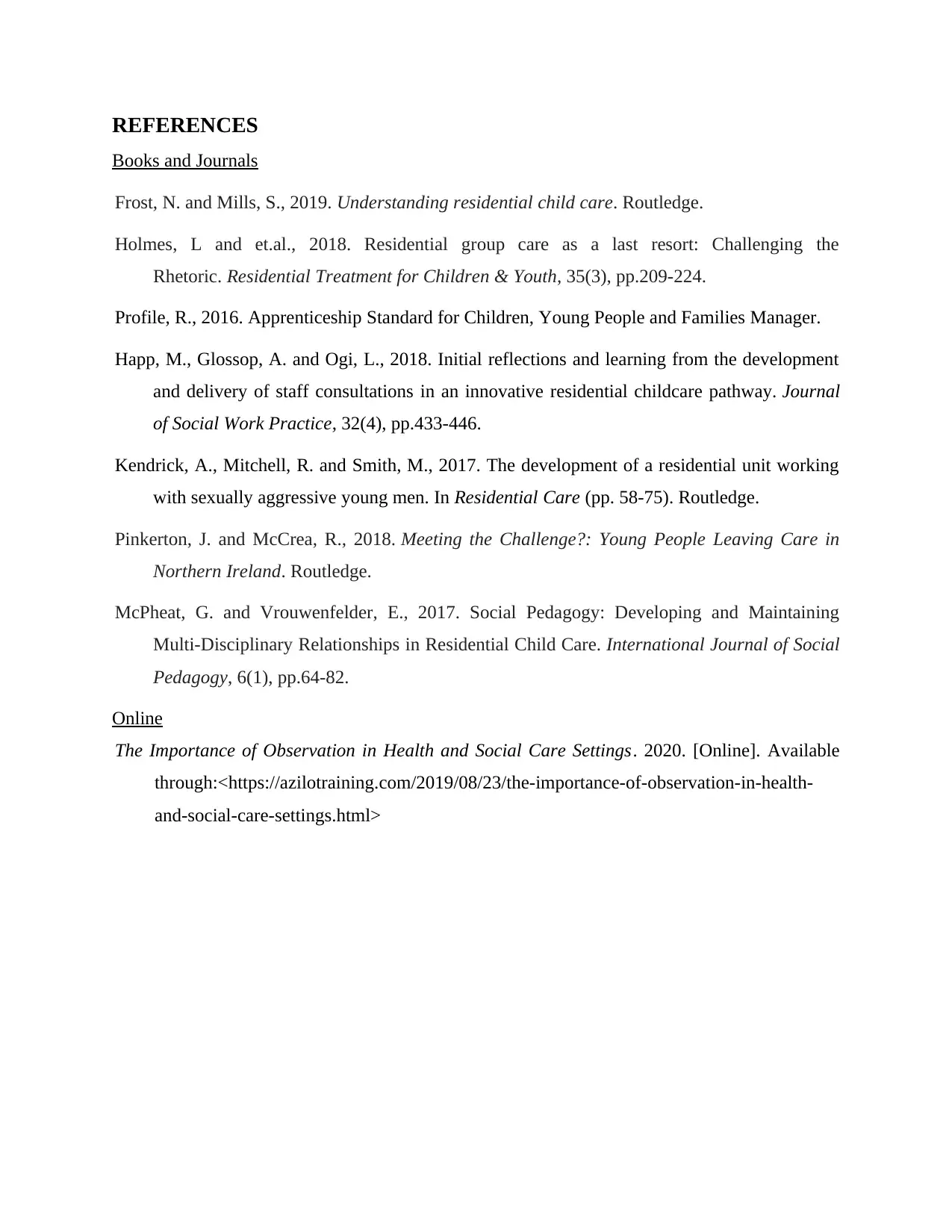
REFERENCES
Books and Journals
Frost, N. and Mills, S., 2019. Understanding residential child care. Routledge.
Holmes, L and et.al., 2018. Residential group care as a last resort: Challenging the
Rhetoric. Residential Treatment for Children & Youth, 35(3), pp.209-224.
Profile, R., 2016. Apprenticeship Standard for Children, Young People and Families Manager.
Happ, M., Glossop, A. and Ogi, L., 2018. Initial reflections and learning from the development
and delivery of staff consultations in an innovative residential childcare pathway. Journal
of Social Work Practice, 32(4), pp.433-446.
Kendrick, A., Mitchell, R. and Smith, M., 2017. The development of a residential unit working
with sexually aggressive young men. In Residential Care (pp. 58-75). Routledge.
Pinkerton, J. and McCrea, R., 2018. Meeting the Challenge?: Young People Leaving Care in
Northern Ireland. Routledge.
McPheat, G. and Vrouwenfelder, E., 2017. Social Pedagogy: Developing and Maintaining
Multi-Disciplinary Relationships in Residential Child Care. International Journal of Social
Pedagogy, 6(1), pp.64-82.
Online
The Importance of Observation in Health and Social Care Settings. 2020. [Online]. Available
through:<https://azilotraining.com/2019/08/23/the-importance-of-observation-in-health-
and-social-care-settings.html>
Books and Journals
Frost, N. and Mills, S., 2019. Understanding residential child care. Routledge.
Holmes, L and et.al., 2018. Residential group care as a last resort: Challenging the
Rhetoric. Residential Treatment for Children & Youth, 35(3), pp.209-224.
Profile, R., 2016. Apprenticeship Standard for Children, Young People and Families Manager.
Happ, M., Glossop, A. and Ogi, L., 2018. Initial reflections and learning from the development
and delivery of staff consultations in an innovative residential childcare pathway. Journal
of Social Work Practice, 32(4), pp.433-446.
Kendrick, A., Mitchell, R. and Smith, M., 2017. The development of a residential unit working
with sexually aggressive young men. In Residential Care (pp. 58-75). Routledge.
Pinkerton, J. and McCrea, R., 2018. Meeting the Challenge?: Young People Leaving Care in
Northern Ireland. Routledge.
McPheat, G. and Vrouwenfelder, E., 2017. Social Pedagogy: Developing and Maintaining
Multi-Disciplinary Relationships in Residential Child Care. International Journal of Social
Pedagogy, 6(1), pp.64-82.
Online
The Importance of Observation in Health and Social Care Settings. 2020. [Online]. Available
through:<https://azilotraining.com/2019/08/23/the-importance-of-observation-in-health-
and-social-care-settings.html>
1 out of 8
Related Documents
Your All-in-One AI-Powered Toolkit for Academic Success.
+13062052269
info@desklib.com
Available 24*7 on WhatsApp / Email
![[object Object]](/_next/static/media/star-bottom.7253800d.svg)
Unlock your academic potential
Copyright © 2020–2025 A2Z Services. All Rights Reserved. Developed and managed by ZUCOL.




